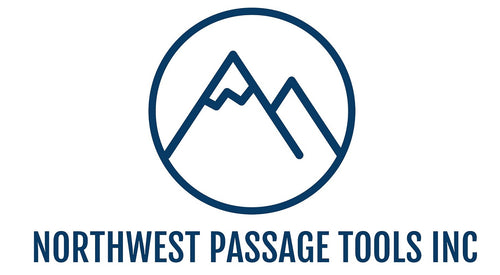Blade Angle Gauge for Eclipse Sharpening Guide
Regular price
$29.99
Sale
We use a Veritas Honing Guide for sharpening narrow chisels and skewed plane blades, but otherwise, we prefer to use something lower cost, faster and simpler - the Eclipse Sharpening Guide, which works on the majority of plane irons and chisels. We designed this Blade Angle Gauge to work with the original Eclipse Sharpening Guide and also all the knockoffs that have appeared on the market (usually grey with raised letters on one side for Chisel Projection and Plane Iron Projection).
This gauge is made from dark grey ABS plastic that has been 3D printed, which gives the flat surfaces a light woven texture. It has distances built into the gauge for plane blade angles between 25° and 50° in 1° increments that are marked on the gauge in a contrasting color (typically black, but occasionally red or blue as shown in photos). It also has corresponding steps for chisel angles using the lower blade clamp, from 20° to 40°. Each angle step has a 10 mm (3/8") wide step for the edge of the blade to register against. The gauge can either be used while held with one hand or can be mounted on a board using two #8 flat head wood screws in the holes provided - the board can then be clamped to a bench or in a vise.
The range of angular steps provided for both chisels and plane irons covers a wide range of use - from paring chisels at angles as low as 20° up to mortise chisels at 40°, and plane irons with 25° bevels for end grain work in low angle bevel up planes (giving an effective planing angle of 37° with a 12° bed angle) to a 50° angle for bevel up plane irons (for use in difficult woods, where the 12° bevel angle results in a 62° effective planing angle to produce Type II shavings).
When using the lower blade clamp of the Eclipse Jig to sharpen chisels, the angle setting for a given blade projection is accurate, regardless of chisel thickness. However when using the upper blade clamp to sharpen plane blades (and any other honing jig where the front/front of the blade/iron is the registration surface), the blade thickness does affect the sharpening angle - the angular distances in this gauge are set for a 3/16" (4.7 mm thick) plane blade, which is the thickness used for both Veritas and Lie Nielsen bevel-up bench planes - if you are using thicker or thinner plane blades, then the sharpening angle will be different.
The table below shows the angle correction required at different target angles for blades of various thicknesses including Old Stanley (about 0.080"/2mm), Modern Stanley replacement blades (often about 0.100"/2.5mm), Veritas and Lie Nielsen Block Planes (most around 1/8"/3.2mm), and high end/infill planes (often with blades as thick as 1/4"/6.35mm).
| Effect of Plane Blade Thickness on Sharpening Angle for Eclipse Sharpening Jig | ||||||
| Angular Corrections shown are in comparison with a 4.7 mm (3/16") thick blade | ||||||
| Blade Thickness mm(fraction) | At 25° | At 30° | At 35° | At 40° | At 45° | At 50° |
| 2 mm (0.080") | +1.6° | +1.8 | +2.1° | +2.1 | +2.2° | +2.2° |
| 2.5 mm (0.100") | +1.3° | +1.4 | +1.7° | +1.7° | +1.8 | +1.8° |
| 3.2 mm (1/8") | +0.9° | +1.0° | +1.2 | +1.2° | +1.2° | +1.2° |
| 4.7 mm (3/16") | 0° | 0° | 0° | 0° | 0° | 0° |
| 6.35 mm (1/4") | -1.0° | -1.2° | -1.2° | -1.3° | -1.3° | -1.3° |
For most applications, these small angle variances due to blade thickness shouldn't be critical - generally repeatability is more important than accuracy. However, if desired, these errors can be compensated for by moving up or down the gauge settings by 1 or 2 degrees in the direction shown in the table - for example for a 2 mm thick blade at 30°, it should be sharpened at the 32° setting on the gauge in order to produce a 30° bevel. An approximate guideline is to add 2° to the setting for plane blades that are 2 mm to 2.5 mm (0.080" to 0.100") thick, add 1° for blades about 3.2 mm (1/8") thick, and subtract 1° for blades that are 6.35 mm (1/4" thick).
Another advantage of having single angle steps in the gauge is that it makes it quick and easy to resharpen a secondary bevel at an angle 1 or 2° steeper than the previous one when the secondary bevel is getting too large, rather than regrinding the primary bevel. For bevel up planes, we suggest trying primary angles of 28 to 32° rather than 25° which is often used - steeper angles are faster to hone because there is less material to remove - for secondary bevels try 33 to 35° and then resharpening at successively higher angles until getting within 2 or 3° of the plane bed angle. Another advantage of using higher primary and secondary bevel angles on a bevel down plane is that it is easier and faster to add a camber to the blade. For bevel up planes, we suggest buying a spare plane blade or two and sharpening them at different angles to make it easy to switch effective planing angle by changing blades. We suggest writing both the primary and secondary bevel angles on each blade so that you know what was last used.
This gauge is designed and made in Canada by Northwest Passage Tools.
